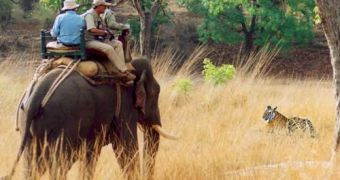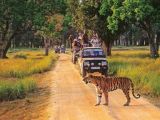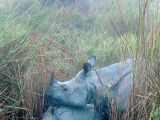The elephant was called "hatti", the bear "balu", the deer "sambar" and the tiger "bagh". Even if in his political and social writings Richard Kipling proved pejorative and even racist towards the Indians, he had as a source of inspiration the Hindu names of the beasts to create a universe that turned on the imagination of generations of children worldwide.
You can hear these names repeated by the guides, while penetrating into a dense forest of sal trees (Shorea) in a chilly morning of January. This is the same forest from the "Books of the Jungle". To get even closer to the reality of the books, at the edge of a pool of mossy water lies a statue of Vishnu, a stone giant leaning over the bed of a seven rings cobra snake, Ananta. These hills, forests and savannas of the central India, the tiger's territory, inspired Kipling.
The most fascinating thing is that what Kipling saw 150 years ago still exists, in a country of over 1 billion people. Against the demographic pressure, farming activities and fuel necessities, a miracle maintains over half of the world's tiger population in India. Deforestation was stopped only in recent years.
Perhaps Hinduism, partially a totemic religion, whose pantheon is based on animals, has an important role. Ganesha, half man half elephant, and Hanuman, half man half monkey, are the main cult forms in which fauna intermingles with the divinity.
Elephants were domesticated and used for farming, in transport or for carrying tourists looking for tigers. Even today, you can see in a city like Delhi, with over 10 million inhabitants, elephants parked on a sidewalk. The black faced gray langur monkeys are common in the cities, while in the forests, through their calls, they act like alarm systems for the chital (spotted) deer and sambar deer against the proximity of a large predator.
The symbol tree for the Indian jungle could be the long lived sacred fig or pipal (Ficus religiosa), whose giant roots develop the trunks added to the main one. The pipal is worshipped by both Buddhists and Hindus, the former because Buddha reached illumination below a pipal, the latter because it is dedicated to Vishnu.
India is not Kenya and the facilities for the safari cannot be compared, but even so an extensive network of national parks and reserves are maintained against poaching, at prices more than accessible and with a proper infrastructure. Africa comes with its big fives: a rhinocero, a buffalo, a lion, an elephant, a leopard. Surprisingly, all these five animals are found in India and the lion and the leopard are even the same species. But the Indian lion is strictly located to Gir forest in northwest, while the Indian rhinos and buffaloes are extremely rare and located just in the northeastern India.
India's big fives include the tiger, the sloth bear, gaur (the huge Indian wild cattle), besides the other species. Ranthambhore National Park (Rajahstan, north India) is considered the best place in the world to see tigers, but tiger watching developed also in the Bandhavgarh National Park and Kanna National Park (both in Madhya Pradesh, Central India).
In Bandhavgarh, there is a mix of sal forests and savanna. The park hosts 37 species of mammals, 250 of birds (including peacocks) and 70 of butterflies.
Tiger watching requires about 3-4 days to see an animal for a few seconds and the best hours are during sunset and sunrise. The back of an elephant is the best place to see a tiger, both for security and as the feline is not scared by the huge beasts.
To see the big Indian rhinoceros, you have to travel to Kaziranga National Park (Assam, northeastern India, a region of political turmoil), also rich in elephants and tigers, or Royal Chitwan National Park (Nepal), also home of the tiger, in the swampy plain bordering Himalaya to the south. There are much less rhinos than tigers, about 1,500 individuals, as they fell victims of poaching for their sole horn (unlike in the double horned African rhinos).
Other national parks that are worth visiting for an Indian safari are: Corbett (Uttarakhand, India's oldest national park, for tigers and elephants), Sunderbans (West Bengal, for tigers), Panna (central India, for tigers), Simlipal (Orissa, eastern India, for elephants and tigers), Periyar (Tamil Nadu, southern India, for elephants), Nilgiri (Biosphere's Reserve, in Tamil Nadu, for elephants), and Gange's Mouths (Bangladesh, for tigers).

 14 DAY TRIAL //
14 DAY TRIAL // 

